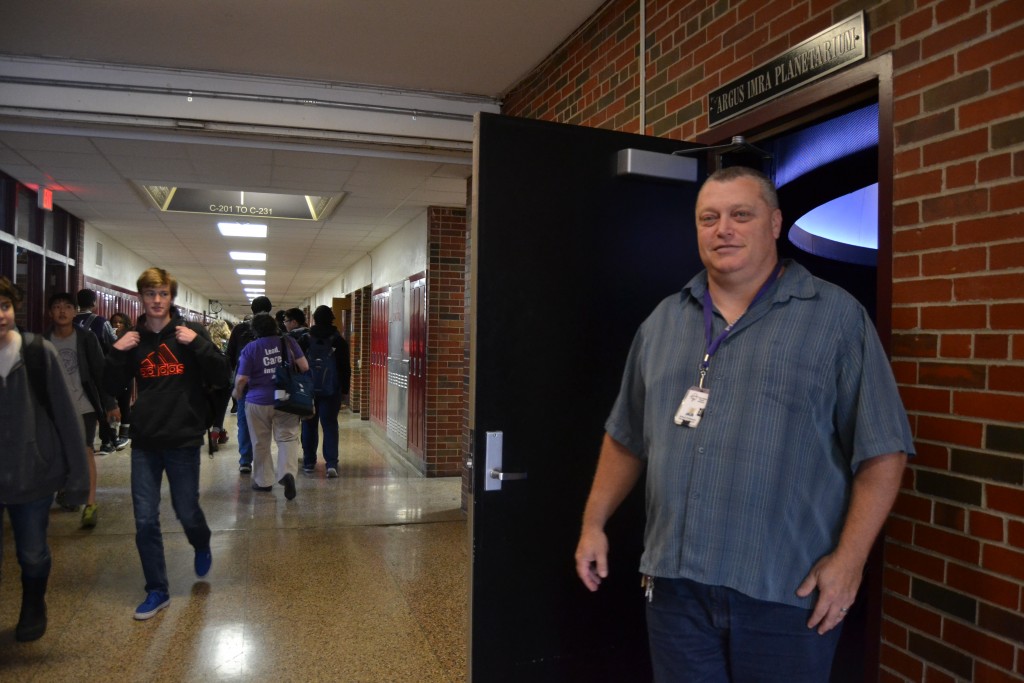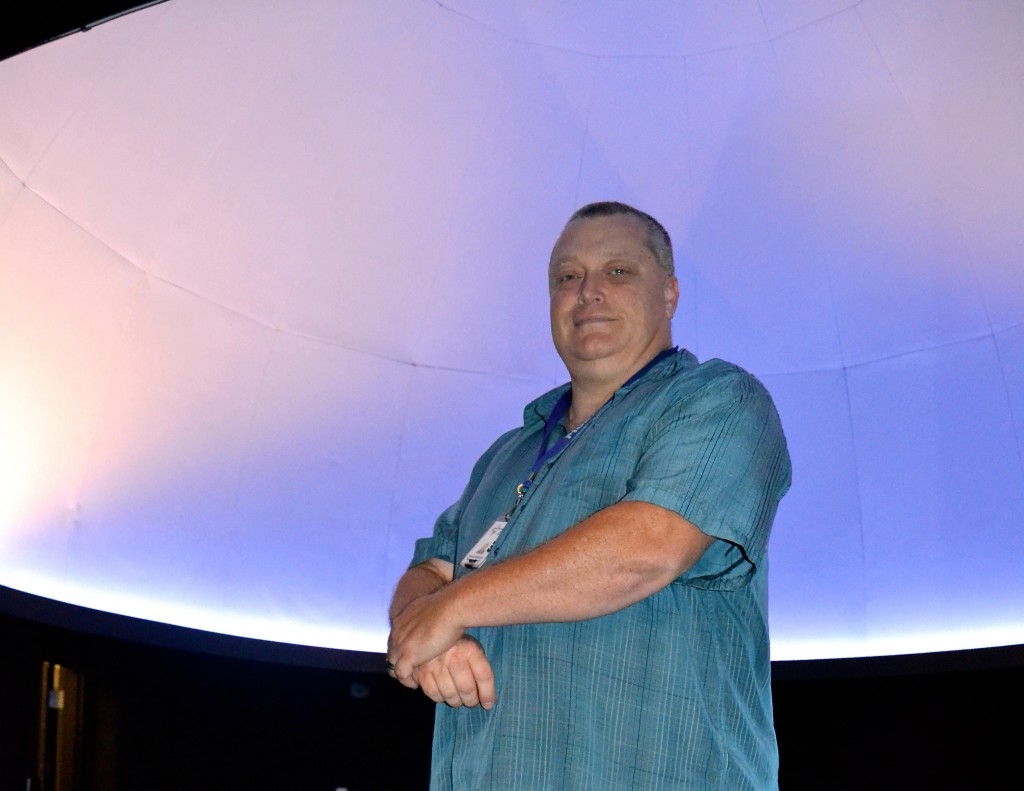
Story and photos by Jo Mathis
AAPS District News
When the Argus Planetarium was installed in the new Ann Arbor High School in 1956, it was the first high school planetarium in the country.
Since then, thousands of AAPS students have been awed by the stars, planets and constellations projected on the dome above them.
For AAPS planetarium director/earth science teacher Ron Robinson, introducing those students to the wonders of the galaxy means watching the light turn on time after time.
“I’m not an elementary teacher,” says Robinson, sitting in his small office adjacent to the planetarium, “but when you see those eyes, you know: I gotcha. You’re not going to wriggle. You’re not going to squirm. I gotcha. And I’m going to have you for years afterwards.”
Evans & Sutherland, which has more than 300 installations around the world, recently chose Pioneer’s planetarium as one of the world’s top 10 planetariums with an educational outreach.
Robinson enjoys the reaction he gets from people when he tells them he’s a planetarium director—in a high school.
When he brags that the planetarium is actually part of the curriculum, the reaction is even better.
Robinson can relate. When he became an earth science teacher at Pioneer in 1992, he walked into the planetarium, which is directly off a main hall near the media center, and couldn’t believe what he was seeing.
“That’s all it took to get me in the door,” he recalls. “Yes, I’m a science geek. So it wasn’t a hard sell. But it was one of those things that it just drips history. When you think of everybody who stepped foot through that door, who’s been in the room, the two astronauts in the 1960’s who were trained in the room …”
The Argus Planetarium was installed with a donation from the Argus Camera Company. John Rosemergy was the director until 1987, when Steve Schaffer took over until 2011, when Robinson became director.
Each had apprenticed for the previous director for many years. Robinson, in fact, helped with the program for 19 years—donating untold volunteer hours.
When he became director after Schaffer retired, he hit the ground running.
“I already knew the equipment and I already knew the material backwards and forwards because I helped develop it,” he says.
There have been nights he’s slept at the office in order to have plenty of time to write the code for an upcoming program requested by a teacher.
“When you make a promise, that’s what you do,” he said. “You do it because you want the kids to have that experience.”
The planetarium was renovated in 2013, around the time it received funding from IMRA, a global company specializing in ultra-fast fiber laser technology. The name was then changed to Argus IMRA Planetarium.
The 52-seat planetarium offers programs for third, sixth and 10th graders, as well as eight different programs for the district’s 12th grade astronomy classes alone.
Robinson also has special disorientation programs for high school psychology students, which he calls “a blast.” Students sit back and experience a film shot with a 360-degree Go Pro camera inside a Swiss version of the Blue Angels, over the Swiss Alps.
Also impressed are the eighth graders who are treated to a show at the planetarium during orientation.
“I get ’em for four and a half minutes, and that four and a half minutes, they do remember!” says Robinson. “When they come by the next year as ninth graders, they’ll say, `Oh yeah! Last year, wow! I can’t believe you did that!”
Robinson spends a good amount of time securing private funding to support the maintenance of the equipment, oftentimes trading his professional expertise for access to updated materials and programs.
In the past year, Robinson has forged about six informal partnerships with planetariums around the world, which share software programs.
And that’s a win-win for AAPS students, who are then treated to some pretty amazing shows such as Sunstruck!
Students ooh and ahh the very most when he takes them on a journey from Earth all the way out to the edge of the visible universe some 13.8 billion light years away.
“They can see those areas that we’ve studied a lot, and those areas that we haven’t studied a lot,” he says. “And they get a better feel for science in general, because it’s not just, `Oh, yeah. They’ve filled in the gaps.’ `No, no, no, no. This is what we know. These are the areas you can contribute on.’ And then they come away with the sense that, `Oh, we don’t know everything yet. This would be cool to figure this out.’”
Over the next three years, AAPS will undergo a curriculum realignment to meet Next Generation Science Standards, and the planetarium will expand to offer programs for first and fifth graders.
And that takes a lot of specialized work.
At one point, in addition to his full-time job at AAPS, he was one credit shy of teaching full-time at Washtenaw Community College while also teaching online courses at Michigan Virtual University.
Now, he works strictly for AAPS, devoting any extra time to the planetarium, which demands a lot of coding, upkeep, networking with other planetarium directors, and working with teachers to figure out what to feature.

Nevertheless, Robinson loves his job.
“I have cool toys,” he says. “I have a cool job. I’m working on a piece of hardware from the man that invented computer graphics. Ivan Sutherland is the father of computer graphics. To a geek, I’m running the geek’s geek’s system. When E & S comes out to see me, I’m like a kid in a candy store.”
The planetarium has inspired future astronomers, engineers, and physicists, some of whom have recalled the first time they attended a program there in sixth grade.
“You have the ultimate ability to turn them on and keep them turned on,” he says with a smile. “What’s better than that?”

I was very proud to be one of the first sophomore students to be trained to operate the planetarium in 1956 Obviously it has been much upgraded from those days. Computers in those days filled rooms of their own. I also operated the school weather station under Mr Buhl initially and then Mr. Rosmergy who was also my Chemistry teacher.My interest in astronomy started in fourth grade at Perry elementary school. I continued my interest in a wide range of sciences and still do today through the internet. I even took a trip to see a total solar eclipse in mid Atlantic in the early 70s. My physics education came from M. Rees. I hope I’ve remembered the spelling of those names as I graduated in 1959.
I think it should be open to the public after hours and/or on weekends. And I would charge a fee. Might even raise some money for AAPS!